BRIEF REPORT:
OSAKA – THE UNEXPLORED PUBLIC CYCLING POWERHOUSE
Osaka, the third largest city in Japan, reveals a vibrant, yet largely ignored, public cycling culture. This brief SPORTIFY CITIES report aims at bridging this information gap by assessing the city’s impressively high bicycle commuting shares – up to 30% in some of its wards. To some surprise, provision of bicycle infrastructure appears to have had little influence on Osaka’s extremely high public cycling popularity levels, challenging the one-fits-all Copenhagen-style urban bicyclism recommendations that are being largely blindly adopted by local governments across the globe. Osaka and other Japanese cities have proven that construction of large-scale, capital-intensive bicycle infrastructure is not a critical factor in becoming a top-tier public cycling city.
With nearly 2.7 million people Osaka is the third largest city and one of the key economic regions in Japan. Thanks to the popularisation and celebration of food cultures around the world, Osaka has also become known to the outside world as the culinary capital of Japan.
But what is barely talked about is the fact that public cycling is ingrained in Osaka’s city life – with residents of all ages cycling to work, train stations, supermarkets, leisure facilities and schools. Yet although Osaka City is the national leader in public cycling, it may somewhat come as a surprise that the city’s formidable public cycling culture gets largely overlooked by academics and international bicycle advocacy groups.
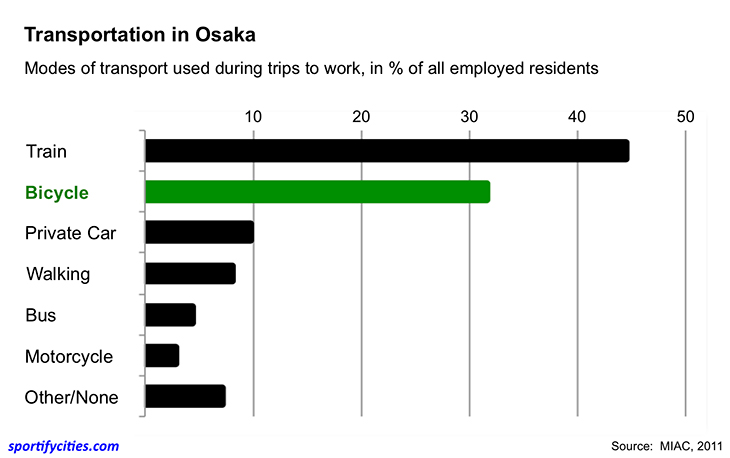
Bicycle is the second-most popular commuting option in Osaka. More than 30% of employed Osakaites choose to ride a bike at some point during their trip to work (MIC dataset, 2011).
According to the latest available government figures, 32% of employed Osaka residents use a bicycle at some point of their trip to workplace – while 26% use it as the sole transportation mode, 6% of commuters cycle to a nearby train station before catching the train to work (the highest overall figure of all medium- to large-sized cities in Japan). Among the 47 prefectures in Japan, the Osaka-fu demonstrates the highest bicycle commuting share (26.6%), followed by Kyoto-fu (20.2%), Saitama-ken (19.8%) and Tokyo-to (18.6%). The prefectures with by far the lowest bike penetrations are the hilly Okinawa-ken and Nagasaki-ken where merely 2.8% and 3.5% of employed residents, respectively, use a bicycle at some point of their commute to work. For Japan the overall bicycle commuting share is 14.5%.
As illustrated below, the percentage of bicycle commuters using a bike as the only means of transportation vary moderately across Osaka’s 24 wards: the centrally located Tennoji ward demonstrates the lowest share of slightly above 19%, while the south-eastern wards of Hirano and Ikuno can take pride in reaching impressively high levels of 32%.

Pervasiveness of bicycle commuting in Osaka. Across the City of Osaka 26% of employed Osakaites use a bike as the sole mode of transportation to get to their workplace. On the evidence available, among large-sized cities (with more than 1 million residents) Osaka would come top of an OECD-countries ranking (MIC dataset, 2011).
The reasons for Osaka’s remarkable bicycle commuting shares are, of course, multi-faceted. Thus it is not the purpose of this brief report to comprehensively analyse and discuss all probable contributing factors. But there are a few evident aspects that could, at least to some extent, explain Osaka’s love affair with this practical mode of transportation.
For instance, across Osaka’s wards the level of bicycle commuting is greater in wards in which taking public transport system is far less prevalent; according to the latest official national datasets, the relationship between bike mode share and the use of public transport system is negative (the correlation is statistically significant; r = –0.87, p < 0.05). The reasons for choosing bicycles over public transport could be manifold: poor public transport links between employment sites and workers’ residences, bicycle-favourable distances from residences to locations of employment, or the residents’ perception of overpriced public transportation – just to name a few key reasons.
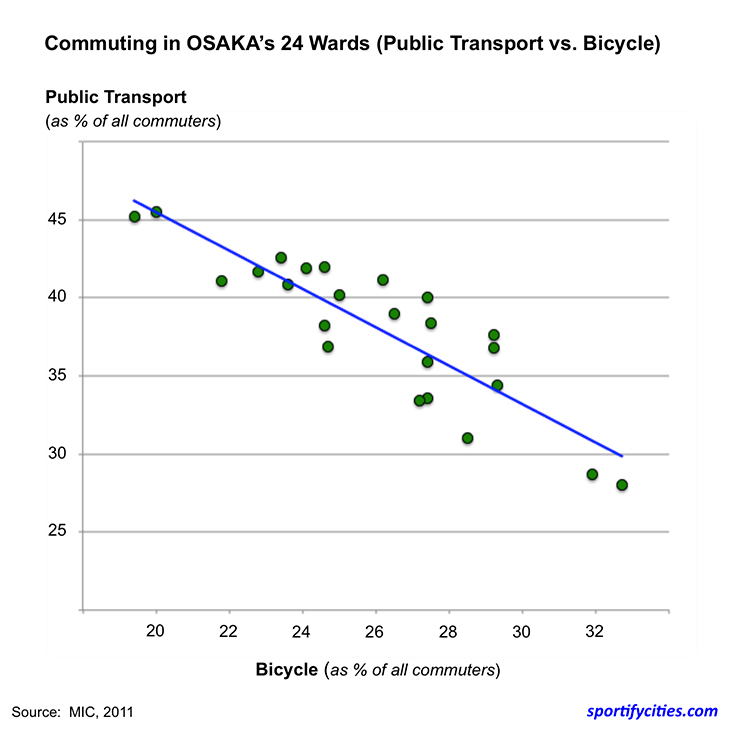
In Osaka there is a close inverse relationship between the percentage of commuters who only take public transport system and the proportion of employed Osakaites who cycle to work (MIC dataset, 2011).
But in Osaka public cycling is not only popular with commuters. Rather, residents from all walks of life use ordinary bicycles to get to grocery shops, leisure and educational facilities, local bars and nearby train stations. Given such impressive popularisation of biking, this Japanese city must be taken into consideration as one of the top-tier public cycling powerhouses in the developed world.
One important contributing factor, among others, to Osaka’s great public cycling culture is the city’s favourable urban setting. In Osaka, a large part of its motorized traffic travels via overhead expressways. On the ground, on the other hand, the city succeeds in channelling motorized traffic – at a moderate speed of 50km/h – through a network of selected main roads.
Much of its metropolitan area, however, consists of narrow bi-directional roads or one-way neighbourhood alleyways, providing urban cyclists with abundance of relatively calm and safe route options to choose from when riding to their destinations. In addition, rigorously enforced speed limit of 30km/h on narrow roads slows down the local motorized traffic and creates fairly safe conditions for local public cyclists.
And if main roads need to be crossed, cyclists can safely do it at traffic junctions which are located at regular intervals; in this way, residential and commercial areas remain physically connected to most locations of interest, ensuring relatively smooth bike riding.
While international bicycle advocacies view bicycle-specific infrastructure as one of the key measures for boosting bicycle popularity levels in cities around the globe, Osaka’s remarkable public cycling culture appears to have emerged despite lacking such costly infrastructure. It is true that since the 1980s Osaka’s municipal government has been designating urban space for bicycle parking zones on a large scale. This urban policy, however, was only enacted because a few decades ago the daily build-up of randomly parked bicycles near train stations and around commercial areas reached intolerable levels.
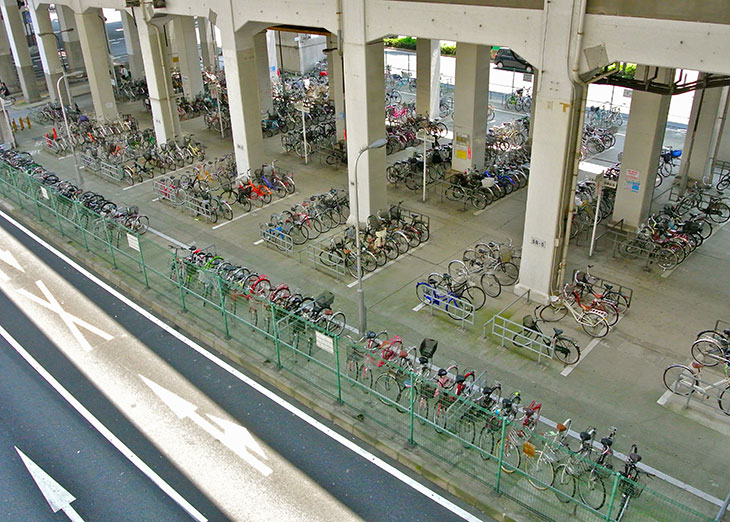
A well-ordered bicycle parking zone located under an elevated train line. Such designated areas are in high demand in Osaka, as around 6% of employed residents commute by bike to nearest train stations.
To be clear, over the past three decades the provision of bicycle parking zones in Osaka has been a reactive rather than a proactive policy; as explained above, public cycling was ingrained in Osaka’s city life by the time the local government came to the conclusion that providing local cyclists with the much-needed parking lots was inevitable due to the growing demand-supply-mismatch regarding bicycle parking areas (for more information see the special Sportify Cities report on ‘Tokyo – The World City of public cycling’).
Over the years large outdoor and indoor bicycle parking areas have eventually been made available at many locations of interest – yet predominantly near train stations. The utilisation of designated bicycle parking lots, however, comes with a price tag, as many parking areas are classified as pay-as-you-use parking zones; there are various paying schemes to choose from, with a temporary (one-day) ticket costing Yen 150 (US$1.40 or €1.25 – at the exchange rate in June 2016).
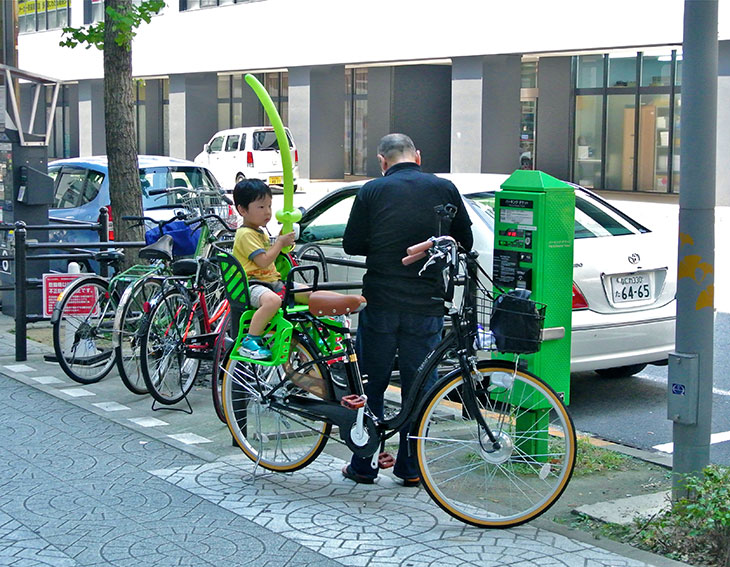
In the central wards regulated pay-as-you-use bicycle parking zones are typical features of their urban design.
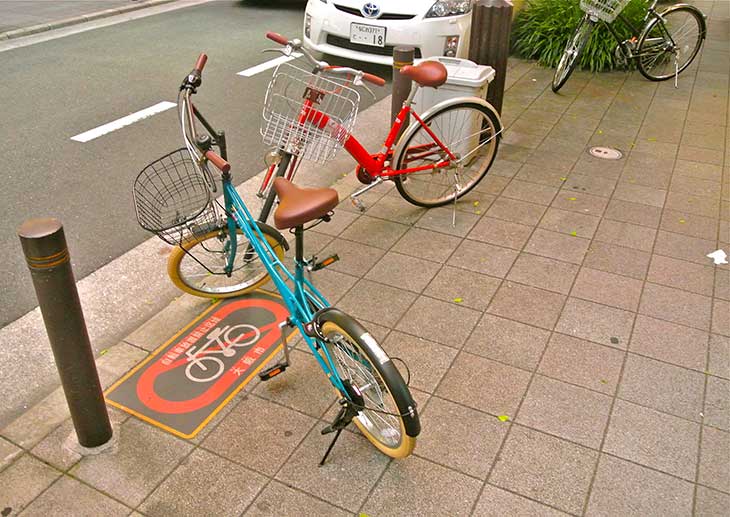
‘No bicycle parking zones’ are regularly ignored by Osakaites.
The lack of an extensive network of segregated bicycle lanes is another interesting feature of Osaka’s public cycling culture. Much of the city’s bike traffic occurs on pavements, narrow roads and alleyways. Unless labelled otherwise, public cyclists are legally permitted to ride on pavements. If heavy traffic hinders bike riders to use main roads, they are also free to share the pavement with pedestrians; children, elderly people (older than 70) and physically handicapped residents are permitted to cycle on pavements at all times.
In some parts of Osaka, lavishly wide pavements – with up to 5 metres – are evenly subdivided into designated walking and cycling sections. Yet Osaka’s cyclists do not seem to care much about this well-intentioned separation of pedestrians and cyclists, frequently ignoring the dividing lines altogether. Instead, cyclists like to use such subdivided bike riding zones on pavements as temporary bicycle parking areas, ridiculing the entire concept of designated bicycle lanes.
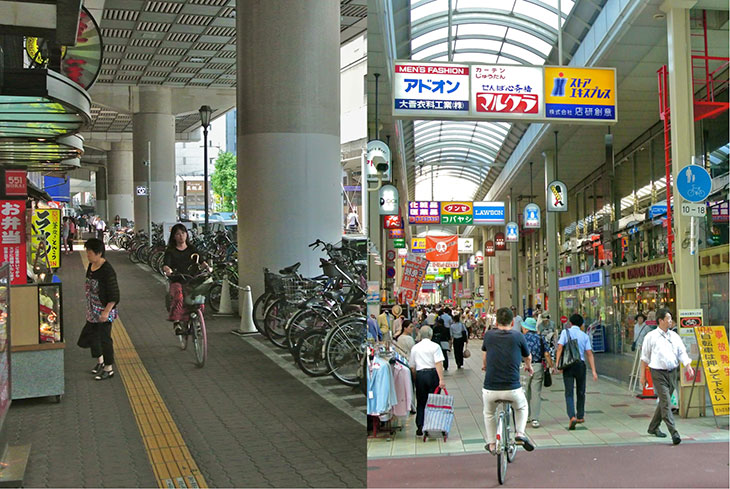
In Osaka public cycling typically takes place on bike-pedestrian-shared pavements.
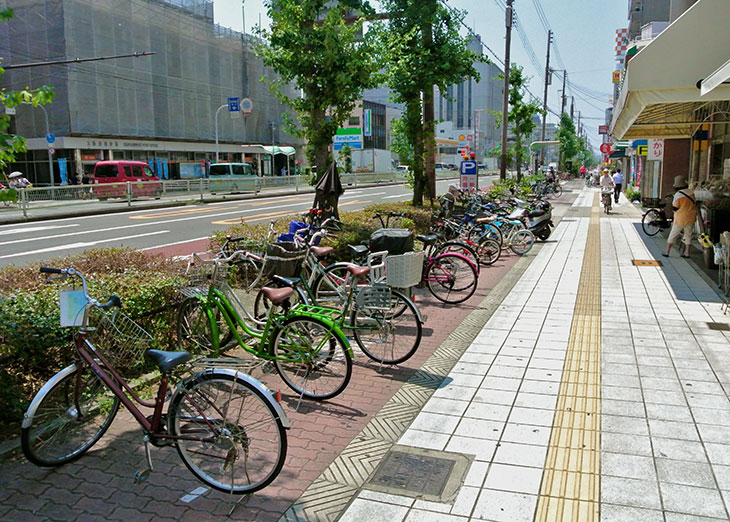
Wide pavements are occasionally subdivided into pedestrian zones and bicycle lanes. Yet pubic cyclists frequently use such designated lanes as bicycle parking areas.
This is not to say that there are no segregated bicycle lanes in Osaka at all. A small number of segregated off-road bicycle lanes along main roads, for instance, has fairly recently been created in selected districts. Judging by the situation on the ground, one may get the impression, however, that local cyclists could have been just fine without such capital-intensive construction of segregated off-road bicycle lanes; that is, the previous urban design in form of wide pedestrians-cyclists-shared pavements along those main roads could have accommodated both traffic participant groups without creating any hazardous conditions. Also, it is reasonable to assume that in these districts the potential benefits of providing segregated off-road bicycle lanes are minuscule compared to the total infrastructure and labour costs.
On the whole, it can be argued that neither the few available segregated bicycle lanes nor the provision of designated bicycle parking areas have facilitated the emergence of Osaka’s public cycling culture. That is, high bike popularity levels prevail in Osaka, although no bike-specific urban planning design is incorporated into its urban setting. This reactive approach offers a stark contrast to the pro-active public cycling guidelines recommended by international bicycle advocacy groups (for more information on this topic see the special report on ‘Tokyo – The World City of public cycling’).
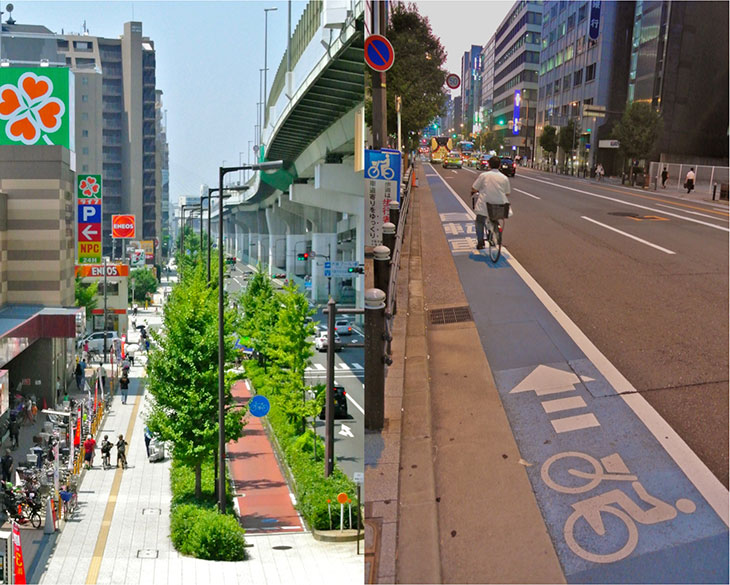
Experimental rarity in Osaka. A separated off-street bicycle lane along a main road in the western blue-collar Minato-ku (left photo). On-street bicycle lanes are occasionally painted on main roads across Osaka’s central wards, such as the Chūō-ku (right photo).
Osaka’s challenging path to recognition
In past few years numerous European cities – most notably Copenhagen and Amsterdam – have revitalized their city brands by highlighting their high public cycling popularity levels (yet not necessarily higher than Osaka’s levels) and by boasting about their provision of large-scale bicycle infrastructure. Furthermore, they have been emphasizing the cool and appeal factor of their public cycling cultures by circulating images of young, photogenic local cyclists wearing fashionable clothes and riding swanky bikes in picturesque urban settings.
By contrast, there is nothing glamorous about public cycling in Osaka. It is generally considered such an ordinary daily activity that Osakaites do not spare much time thinking about it. And they typically choose to use rather inexpensive bicycles to get to work, school, grocery shop, restaurant, or the nearby train station.

The local road traffic law prohibits bike riders from holding umbrellas. Hence, female cyclists often mount their umbrella to a holding device fixed to the handlebar. In doing so, they protect themselves from both rain and the intense ultraviolet light prevailing during Osaka’s sweltering summer.
On top of that, Osaka appears to be lacking the cool factor, which typically boosts a city’s desirability and attractiveness levels among upwardly mobile and globally-minded young people. But in today’s world, this is a crucial aspect of a city image, as great desirability of a city among local and prospective residents ultimately leads to greater presence on social media and travel blogs. For theses reasons alone, the likes of Copenhagen and Amsterdam – the highly promoted public cycling cities in Europe – have a big competitive advantage over Osaka.
Yet despite Osaka’s limited socio-cultural clout, there is no justifiable reason why this top-tier public cycling city continues to receive little credit for its achievement. To make matters worse, academic papers and international bicycle advocacy groups, by and large, fail to display Osaka in their inter-city bicycle commuting graphs and rankings.
Given that this Japanese city would most likely top any public cycling popularity ranking featuring large cities (with more than 1 million inhabitants) in the developed world, such disregard for the city’s impressive public cycling culture is unacceptable. And it would certainly be a shame, if this suppression of information on Osaka’s exceptionally high bike mode shares turns out to be a concerted effort to exclude this city, and other Japanese cities, from the international public cycling conversation. After all, Osaka’s success story of becoming one of the top-tier public cycling cities in the world does not fit the generic “build bicycle infrastructure and they will use it” narrative.
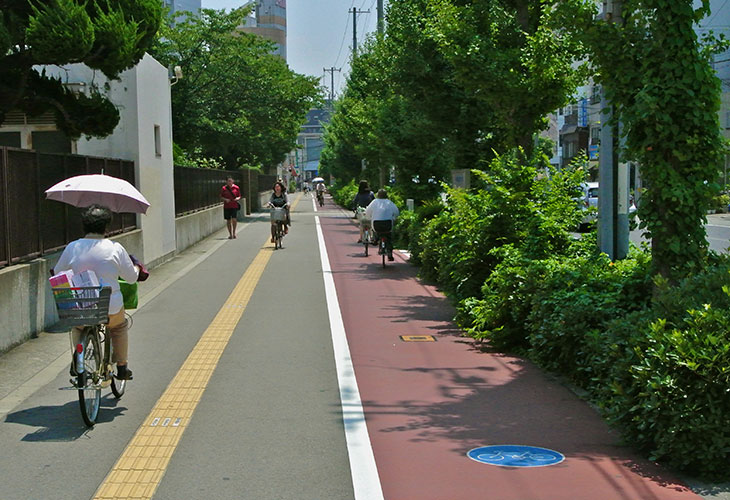
On Osaka’s pavements cyclists usually make the rules, as they clearly outnumber pedestrians. The marked dividing lines are largely perceived as a rather metaphorical separation of pavement users.
That said, there is a lot that Osaka itself could do in order to boost its status as a top-tier public cycling city. So far, though, it has failed to do so. As we live in an era in which health and sustainability themes are becoming more central to city liveability, Osaka could create an instantly recognisable city image by telling the world a compelling story about the emergence of its remarkable public cycling culture and by incorporating it into a cohesive long-term city brand strategy.
Judging by the city’s official statements, however, it is doubtful that Osaka’s policymakers are ready for such novel city profile; for instance, the City of Osaka bizarrely suggests to “refrain from riding your bicycle for non-essential purposes. It takes only about 10 minutes to travel 800 meters on foot”. Besides, as part of its beautification efforts, the municipality government is in the midst of creating an extensive “Bicycle Parking Forbidden Area” in the central Minami ward, one of the key commercial districts, in an effort to actually discourage their residents and workers from riding bicycles.
To be clear, as long as local municipalities consider this popular transportation mode to be a burden rather than a blessing, any attempt of wanting to create an appealing public cycling city identity would surely fizzle out due to lack of authenticity and enthusiasm. In other words, any potential strategy aimed at creating new taglines and boosting Osaka’s public cycling recognisability is certainly doomed to fail, unless the city decides to change its attitude and to embrace its impressive public cycling culture.
